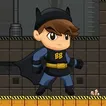



























































































































































Jumping Games: An Exciting World of Leaps and Bounds
Jumping games have captivated players of all ages with their simple yet thrilling premise: navigate through a world by leaping over obstacles and reaching new heights. This genre’s universal appeal lies in its straightforward concept that transcends language and cultural barriers, making it accessible to a global audience. From the early days of pixelated platformers to the immersive 3D environments of today, jumping games have undergone a remarkable evolution, reflecting the growth and innovation within the gaming industry.
At the heart of these games is the joy of movement, the sense of freedom that comes from soaring through the air, and the satisfaction of a perfectly timed jump. They challenge players to think quickly and react with precision, providing a sense of accomplishment with each successful leap. The genre’s evolution has seen the introduction of various mechanics, such as double jumps and wall jumps, which add layers of complexity and strategy to the gameplay.
The design of jumping games is a delicate balance of challenge and fun, requiring developers to craft levels that are engaging, yet not overly frustrating. The level design often incorporates puzzles and obstacles that test the player’s timing and spatial awareness, making each jump a calculated risk.
As the genre continues to grow, jumping games remain a staple in the gaming world, offering endless entertainment and a test of skill. They embody the spirit of play and adventure, inviting players to leap into the unknown and discover what lies beyond the next platform.
Jumping Game Mechanics and Design: Crafting the Perfect Leap
Jumping games hinge on the core mechanics of leaping and bounding, which may seem simple at first glance but are underpinned by complex design principles. The quintessential jump is not just about elevation but also about control and timing. As players progress, they encounter a variety of jumps – from the basic single leap to the more advanced double jump, which allows for mid-air maneuvering and reaching otherwise inaccessible areas. Wall jumps add another layer, enabling players to rebound off surfaces and ascend vertical spaces, turning the environment itself into a puzzle.
The physics of jumping games is another critical aspect, as it influences the feel of the game. The gravity, momentum, and friction must be finely tuned to create a responsive and intuitive experience. Too much weight in the character’s movement can make the game feel sluggish, while too little can make it feel floaty and imprecise. The sweet spot lies in between, where players feel fully in control of their airborne trajectory.
Level design in jumping games is an art form that requires a deep understanding of pacing and challenge. Designers must carefully place platforms, obstacles, and power-ups to guide players through an invisible rhythm of jumps, encouraging them to learn and master the game’s mechanics. The levels must be readable, allowing players to quickly assess their surroundings and make split-second decisions. Strategic placement of checkpoints and collectibles can provide both relief and incentive, keeping players engaged and motivated to push forward.
In essence, the mechanics and design of jumping games are about creating a seamless blend of challenge and joy. Each leap is a test of skill, but also an opportunity for players to experience the exhilarating rush of defying gravity, even if it’s just on screen.
Online Jumping Games: A Community in the Clouds
The digital age has ushered in a new era for jumping games, propelling them into the online realm where players from every corner of the globe can connect and compete. The essence of these games remains unchanged, but the addition of internet connectivity has transformed them into a shared experience, creating a virtual community bound by a love for aerial challenges.
Online jumping games have introduced multiplayer modes that add a competitive edge to the genre. Players can now race against each other in real-time, pushing the limits of their reflexes and strategic thinking. Leaderboards serve as a testament to human tenacity, chronicling the feats of individuals who have mastered the art of the jump. These rankings foster a friendly rivalry and provide a constant incentive for players to improve and reclaim their spot at the top.
The social aspect of online jumping games cannot be overstated. They have become a platform for interaction, where players can share tips, celebrate victories, and commiserate over narrow defeats. This sense of camaraderie is further enhanced by features that allow players to customize their avatars and leave their personal mark in the game world.
Accessibility is also a key factor in the success of online jumping games. With the ability to play on various devices and platforms, these games reach a wide audience, ensuring that anyone with an internet connection can join the fun. The simplicity of jumping games makes them easy to pick up but hard to master, appealing to both casual gamers and dedicated enthusiasts.
In conclusion, online jumping games have created a community in the clouds, a space where players can leap beyond their physical confines and enjoy boundless interaction. As technology advances, this community will only continue to grow, bringing together people through the shared joy of the perfect jump.
The Future of Jumping Games: Innovations and Trends
The horizon of jumping games is teeming with potential, as emerging technologies like virtual reality (VR) and augmented reality (AR) promise to redefine the boundaries of the genre. These innovations offer a tantalizing glimpse into a future where players can experience the thrill of jumping in a fully immersive environment, adding a new dimension to the visceral sensation of height and movement. As VR and AR become more accessible, we can anticipate a wave of new games that leverage these technologies to deliver unprecedented levels of immersion and interactivity.
Accessibility remains a cornerstone of the genre’s future, with developers focusing on creating experiences that are inclusive to all players. This includes designing games that accommodate different levels of physical ability and providing customizable control schemes to ensure that jumping games can be enjoyed by everyone, regardless of their limitations.
The trend towards procedurally generated content is also on the rise, offering endless replayability through dynamically created levels that challenge players in new ways each time they play. This ensures that the jumping game experience remains fresh and engaging, encouraging players to return again and again.
Lastly, the integration of artificial intelligence (AI) is set to introduce adaptive difficulty levels, where the game’s challenge adjusts in real time to match the player’s skill level. This smart scaling of difficulty not only helps to maintain a balanced level of challenge but also supports player progression and long-term engagement.
As we look to the future, it’s clear that jumping games will continue to evolve, driven by technological advancements and a commitment to inclusivity. These games will leap forward, offering novel experiences that captivate the next generation of players while honoring the timeless appeal of the perfect jump.